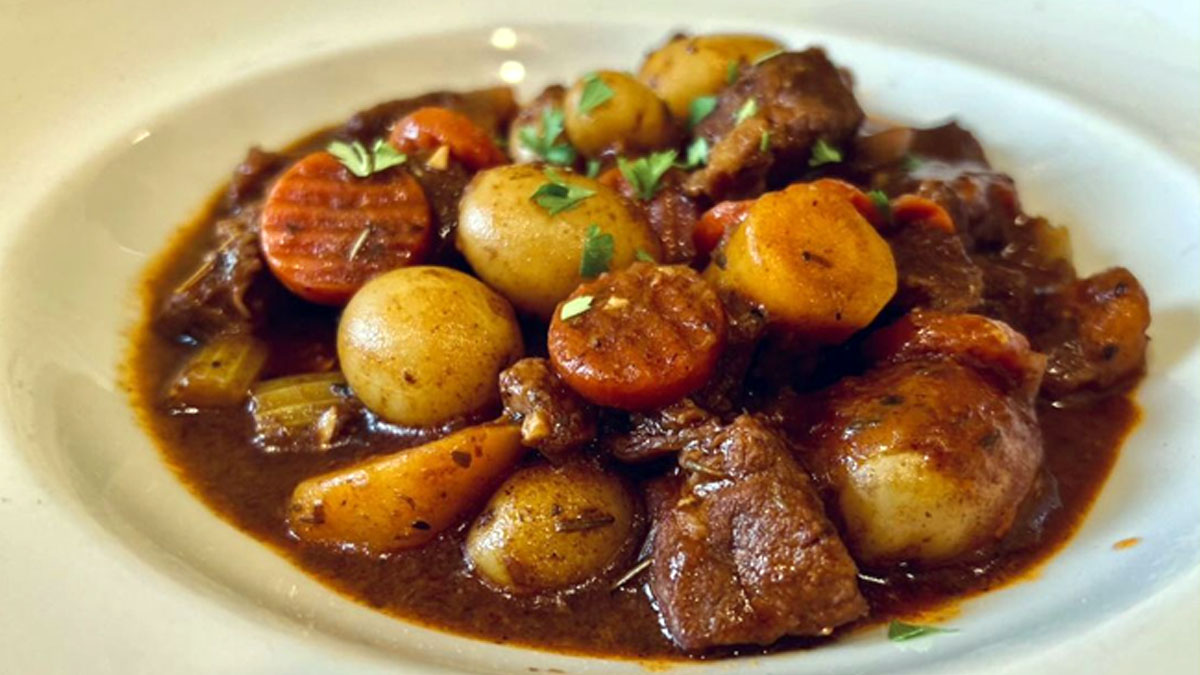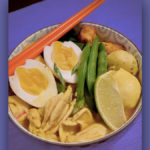Cooler weather definitely calls for a hearty comforting meal so here is my Patikim: a stew derived from the Traditional Irish Beef Stew. Local Irish people may prefer using lamb meat but they are not always readily available. This dish will surely not disappoint because this is made special with the use of Guinness extra stout beer which is less bitter but maltier and mellower than your average beer. The long hours of simmering will definitely pay off as you dip pieces of crusty bread into the stick-to-your-bones sauce. Whenever I have fennel seeds or fresh fennel, I love adding it as well for that very slight anise undertone. You might want to try that as well. This dinner will serve 6 hungry adults.
TRADITIONAL IRISH BEEF STEW
- 2 pounds beef chuck
- 3 tablespoons all-purpose flour
- ¼ cup cooking oil
- 1 large yellow onion diced or 4oz of pearl onions or cipollini onions)
- 5 cloves garlic, minced
- 4 medium firm, waxy potatoes cut in 1-inch pieces or small marbled potatoes
- 2 large carrots, chopped in 1/2-inch pieces
- 2 ribs celery, chopped in 1/2-inch pieces
- 1 large parsnip, chopped into 1/2-inch pieces
- 1 bottle (1 pint or 16 ounces) Guinness Extra Stout
- 1 cup strong beef broth
- 2 tablespoons Worcestershire sauce
- 2 tbsp tomato paste
- 8 oz white button mushrooms quartered
- 1 teaspoon dried thyme
- 1 teaspoon dried rosemary
- 1 1/2 teaspoons salt
- 1/4 teaspoon freshly ground black pepper
- 2 bay leaves
- Salt and pepper to taste
- Cut beef into 1-1 ½ pieces and season with salt and pepper. Dust in flour and in a large heavy bottom pot, heat oil, and brown the beef pieces. Work in batches and do not overcrowd the pot. Remove and set aside.
- Add onions and cook until slightly browned. Add garlic and saute until soft. Do not let color.
- Deglaze the pan with a bottle of Guinness, scraping all the brown bits in the bottom.
- Add the beef, tomato paste, bay leaf, thyme and rosemary, Worcestershire sauce and beef broth. Bring to a boil and simmer for about 1 ½ hours.
- Add vegetables cook until tender. Adjust liquid by adding water ¼ cup at a time as needed.
- The stew is done when the beef is fork-tender. Serve with your favorite crusty bread.

Ever wonder how to make artisanal bread that is crusty and chewy? Here is a recipe for Quick No-Knead Bread that you can whip up in a couple of hours. No more waiting overnight or countless hours. I love making this bread while I make my stew for a warm comforting and scrumptious dinner for the entire family.
COUNTRY BREAD
Ingredients
- 4 cups all-purpose flour, aerated
- 2 1/4 teaspoons active dry yeast instant or rapid rise yeast also works
- 1 1/2 teaspoons salt
- 2 cups warm water just above room temperature
- more flour for shaping the loaf
- Start with a large bowl and a wooden spoon, and add your flour to the bowl. Add yeast on one side of the bowl, and the salt on another side.
- Using a wooden spoon, stir the yeast into the flour on its side of the bowl first and then stir the salt into the flour on its side of the bowl. This will prevent the salt mixing directly with the yeast. Give the whole mixture a few good stirs to make sure everything is combined.
- Measure the water. Make sure the water is just above room temperature; water that is too warm or too cold can kill the yeast and prevent the bread from rising at all. Pour the water in and stir with a wooden spoon. The dough will be rough and a bit sticky, but that’s normal.
- Stir until all the flour is combined. This is not normal bread dough (there’s no kneading involved in this recipe), so you don’t need to be too concerned about the appearance of the dough at this point. Just make sure the ingredients are combined well.
- Cover the bowl with plastic wrap. It’s a good idea to ensure there’s adequate space left in the bowl for the dough to at least double in size. Place the bowl in a warm, draft-free place and let it rise for about 1 and a half hours. (you can make my Irish beef stew recipe below while waiting)
- After the dough has risen, preheat your oven to 450 degrees Fahrenheit. Place your Dutch oven with the lid on in the cold oven and let it heat up with the oven. If your dutch oven is black on the inside, set your oven to 425 degrees Fahrenheit instead of 450.
- Place a piece of parchment paper on the counter and dust it with flour. Rub flour on your hands and scrape the dough away from the sides of the bowl, gathering it in your hands as best you can (it may feel kind of strange and not at all like regular bread dough) and forming it into a circular loaf on the parchment paper. Don’t worry if it still looks a little rough in places. This lends to the rustic look of this loaf.
- Once you have it shaped, the dough needs to undergo a short second rise. The goal is to handle the dough as little as possible at this stage because any amount of tugging at the rough can cause it to deflate after it has undergone its second rise. The next few steps will help prevent this. But don’t worry if it deflates a bit. This bread dough is pretty forgiving.
- Sprinkle flour over the top of the loaf and loosely cover it with a clean kitchen towel. The flour you sprinkle on top also prevents the towel from sticking to the dough so when you take it off at the end of the rise, it doesn’t disturb the dough and wreck the rustic shape you’ve created. Let the dough rise for about 30 minutes. Your oven will also be preheating during this time (and so will your pot).
- Remove the preheated pot from the oven and transfer the dough into the pot as carefully as possible by handling only the parchment paper. Place the lid on the pot and return it to the oven for 30 minutes. Don’t open the oven during this time, and certainly don’t take the lid off the pot; the crispness of the crust develops because of the steam that builds up in the pot during these 30 minutes.
- After 30 minutes have passed, remove the lid from the pot and continue baking for another 10 minutes. After the 10 minutes have passed, remove the pot with bread from the oven and place the bread on a wire rack to cool. You’ll probably hear the loaf crackling as it cools – this is normal. Resist the urge to cut into the bread until it has pretty much cooled completely. The bread continues to bake on the inside even after it has been removed from the oven and cutting it too early could result in the inside becoming gummy or rubbery.
Click here for more stories like this. You may also follow and subscribe to our social media accounts: Facebook, YouTube, Instagram, TikTok, Twitter, and Kumu.






















